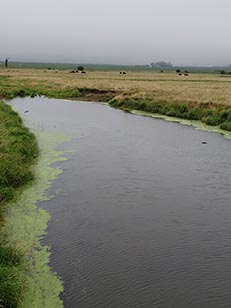Drought “detours” pasture grazing

Blue-green algae along the water's edge.
Photo by Beth Doran.
7/7/22
ORANGE CITY, Iowa – Continuing drought in northwest Iowa is forcing producers to alter their grazing plans. Fortunately they have “detours," said Beth Doran, Iowa State University extension beef specialist in that area.
“Top of the list is reduce stocking rate,” she said. “Early weaning calves is a proven method to reduce the energy requirement of the cow by 25 to 30 percent and lighten the grazing pressure on the pasture. Early weaning is more effective than supplemental creep feeding when forage production is short.”
But this is only part of the equation. If pasture is very short, producers still may be forced to remove a portion of the cows from the pasture or provide supplemental feed such as green-chopped corn or distillers grains.
“Assuming drought continues, consider placing all of the cows in a ‘sacrifice’ pasture,” Doran said. “It’s cheaper to renovate one pasture next year than all of the pastures.”
Rotational grazing can help sustain pasture production, but increased recovery time between rotations is key during drought. This helps maintain the leaf which is the plant’s solar factory, and increases root development allowing for increased uptake of nutrients and moisture.
Doran reminded producers that cool season grasses such as bromegrass, orchard grass and timothy should never be grazed shorter than four inches to allow plant regrowth. During drought, recovery may take 30 to 40 days. For warm season grasses, recovery time approximates 35 to 45 days.
Producers also are cautioned to monitor the growth of blue-green algae in streams and ponds. Blue-green algae produces toxins that affect the nervous system and liver of the animal, and can be deadly if consumed. Consequently, producers need to provide clean water from another source. The algae may appear as a pale green scum on top of the water and cobalt-blue around the edges.
Producers who need supplemental feed are reminded to check with their crop insurance agent before harvesting corn for green-chop or silage.
Farm Service Agency also has assistance programs that may be available in the county such as emergency loans, the Livestock Forage Disaster Program, and grazing or haying of CRP acres. Drought-affected producers are advised to check with FSA to determine eligibility and complete an application.
-30-
The Iowa Beef Center at Iowa State University was established in 1996 with the goal of supporting the growth and vitality of the state’s beef cattle industry. It comprises faculty and staff from Iowa State University Extension and Outreach, College of Agriculture and Life Sciences and College of Veterinary Medicine, and works to develop and deliver the latest research-based information regarding the beef cattle industry. For more information about IBC, visit www.iowabeefcenter.org.
Contact:
Beth Doran, ISU Extension and Outreach beef specialist, 712-737-4230, doranb@iastate.edu
